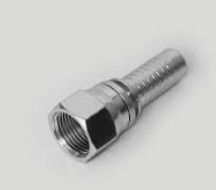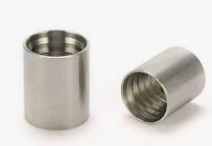In the intricate world of hydraulic systems, where power transmission and control are paramount, there exists a crucial component that often goes unnoticed but plays a pivotal role. We’re talking about hydraulic end fittings. These unassuming components are the unsung heroes of hydraulic machinery, ensuring the seamless flow of hydraulic fluid and the integrity of the entire system.
In this comprehensive guide, we will delve deep into hydraulic end fittings, exploring their significance, types, and their crucial role in the operation of hydraulic systems.
What is the End of a Hydraulic Hose Called?
JIC Female Ferrules
Before we dive into the details of hydraulic end fittings, let’s answer the fundamental question: What is the end of a hydraulic hose called? The answer is simple – it’s called a hydraulic end fitting. These fittings are designed to serve as the interface between the hydraulic hose and various other hydraulic components, such as pumps, cylinders, valves, or even other hoses.
The Significance of Hydraulic End Fittings
1. Ensuring Leak-Free Connections
One of the primary functions of hydraulic end fittings is to create a secure and leak-free connection between different components of a hydraulic system. The tight seal formed by these fittings prevents hydraulic fluid from escaping, ensuring the system operates efficiently without loss of pressure or fluid.
2. Transmitting Fluid Under Pressure
Hydraulic systems operate under high pressure, and hydraulic end fittings play a critical role in withstanding and transmitting this pressure. They are engineered to handle extreme pressure conditions, ensuring the safe transmission of hydraulic fluid.
3. Adaptability and Versatility
Hydraulic end fittings come in various shapes and sizes, each designed for specific applications. This adaptability and versatility make them suitable for a wide range of hydraulic setups, from heavy machinery in construction to precision control systems in aerospace.
Types of Hydraulic End Fittings
Now that we understand the importance of hydraulic end fittings, let’s explore the different types available:
1. Crimp Fittings
Crimp fittings are one of the most common types of hydraulic end fittings. They involve the use of a crimping machine to attach the fitting securely to the hose. This method ensures a robust connection that can withstand high pressure.
2. Threaded Fittings
Threaded fittings are popular for their ease of installation. They are screwed onto the hose and provide a reliable connection. However, they may not be as suitable for high-pressure applications as crimp fittings.
3. Flange Fittings
Flange fittings are known for their exceptional strength and stability. They are often used in applications where extreme pressure and vibration resistance are required. These fittings involve bolting the flange to the hose, creating a robust connection.
4. Quick Disconnect Fittings
Quick disconnect fittings are designed for applications where hoses need to be connected and disconnected frequently. They allow for rapid attachment and removal, making them ideal for mobile hydraulic systems.
FAQs (Frequently Asked Questions)
Let’s address some common questions about hydraulic end fittings:
Are hydraulic end fittings interchangeable?
➡ Yes, some fittings are interchangeable, but it’s crucial to match the fitting to the specific hose and application for optimal performance.
How do I identify the right fitting for my hydraulic system?
➡ Identifying the right fitting involves considering factors like hose size, thread type, and pressure rating. Consult your system’s manual or a hydraulic expert for guidance.
Can hydraulic end fittings be reused?
➡ In some cases, hydraulic end fittings can be reused, but it’s essential to inspect them thoroughly and replace any damaged components.
What should I do if I encounter a hydraulic fitting leak?
➡ If you notice a hydraulic fitting leak, it’s crucial to shut down the system immediately and address the issue. Leaks can lead to system failure and safety hazards.
Are hydraulic end fittings compatible with all hydraulic fluids?
➡ Not all hydraulic fluids are compatible with all fittings. It’s essential to ensure that the fitting material is suitable for the type of hydraulic fluid used in your system.
Can I install hydraulic end fittings myself, or should I seek professional help?
➡ While some individuals with experience can install hydraulic end fittings, it’s recommended to seek professional assistance to ensure proper installation and prevent potential issues.
Conclusion
In the complex world of hydraulics, every component plays a vital role. Hydraulic end fittings, often overlooked, are the linchpin that holds the system together. Understanding these fittings and their importance is crucial for maintaining efficient hydraulic systems.
Whether you’re a seasoned hydraulic engineer or a newcomer to the field, this article has provided valuable insights into hydraulic end fittings and answered the burning question: “What is the end of a hydraulic hose called?”
Remember, the right hydraulic end fitting ensures your system operates smoothly, reliably, and safely.
Post time: Oct-12-2023



